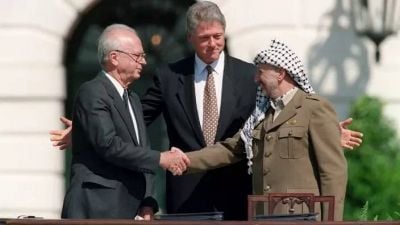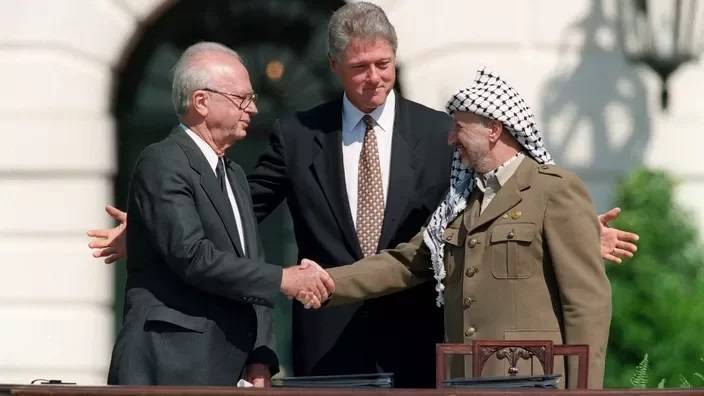
Flanked by American President Bill Clinton, Yitzhak Rabin, the Israeli Prime Minister, and Yasser Arafat, the representative of the PLO, exchange a historic handshake on Sept. 13, 1993. (Credit: J. David Ake/AFP)
In January 1992, the winter in Washington DC was anything but harsh.
The Palestinian delegation, set for the Israeli-Arab peace talks, had just checked into a luxurious five-star hotel along the Potomac River. Meanwhile, negotiators from Jordan, Syria and Lebanon chose lavish accommodations, strategically distanced from one another.
In a curious twist, the Israeli delegation opted for a more modest three-star hotel.
What followed was a year-and-a-half-long negotiation.
For the Palestinians, excitement filled the air. This marked the first session of the peace process in the American capital, and introductions were well underway.
Delegates exchanged broad smiles with press representatives, reciprocated in kind.
At that time, the Palestinian cause enjoyed positive international media coverage — a far cry from today’s realities. Crucially, Palestine was represented by a new generation of leaders. The seasoned PLO veterans — Abu Iyad, Abu Jihad, the Hawatmehs, the Habaches, and Abu Nidal — made way for representatives from the Palestinian civil society, known as the Palestinians “of the inside,” in reference to the Palestinians living in occupied territories.
Hailing from Jerusalem, the West Bank and Gaza, this delegation comprised professors, jurists, doctors, philosophers and other academics — a stark departure from the conventional Palestinian representation.
Even their attire signaled a transformation. Gone were the traditional kuffiyehs, dark glasses and unkempt beards reminiscent of the 1970s and the era of airplane hijackings. Instead, the new Palestinian representatives embraced suits, ties and crisp-looking eyeglasses.
This metamorphosis would wield considerable psychological influence — whether on the Israeli delegates or, at the very least, on their American officials.
The Bush-Shamir showdown
Paradoxically, it was Yitzhak Shamir, the Israeli prime minister at the time, who insisted that the delegation exclusively comprise Palestinians “of the inside.”
In a move that could have derailed the entire process — a process the United States was struggling to launch — Shamir, asserting that Palestine was not a state, successfully relegated the delegation to a sub-delegation officially part of the Jordanian one.
In a curious dance of diplomacy, Washington appeared to acquiesce. From the outset of the talks, American officials turned a blind eye to the reality that Palestinian negotiators, namely Faysal Husseini, Saeb Erekat, Sari Nusseibeh, Hanan Ashrawi, Nabil Chaat, Ghassan al-Khatib and their companions were, in essence, the sole representatives of Palestine.
The physical separation of the Arab delegations, in different hotels, conveniently served as their alibi in this regard.
The Lebanese delegation, however, presented a different scenario. Despite their physical separation from their Syrian counterparts, it couldn’t mask the undeniable fact that Beirut’s diplomacy was wholly reliant on Damascus at the time.
Shamir was unquestionably a formidable, bitter figure.
A proponent of a Greater Israel, he exclusively referred to the West Bank as Judea-Samaria. As a former leader of a terrorist group, notably the Stern, he managed to escape from a British camp in Eritrea in 1947.
Having orchestrated or sponsored numerous violent attacks against the British in Palestine and beyond, he would not have willingly participated in the unfolding events in Washington if not for the George W.H. Bush administration’s (1988-92) determined efforts to compel him.
Having recently emerged victorious from the Cold War following the collapse of the Soviet bloc and gained nearly universal prestige after the resounding success of the Arab-international coalition it assembled to oust Saddam Hussein from Kuwait, the US was resolute in preventing any extremist, whether of Jewish origin or otherwise, from squandering the opportunity to position itself as a peacemaker in the Middle East.
Confronted with the Yitzhak Shamir-Ariel Sharon duo (the latter serving as housing minister at the time), which was extending its influence in the West Bank from a distance, President Bush and then-Secretary of State James Baker appeared to be on the offensive.
Throughout 1991, Washington reiterated almost daily that settlements were the primary obstacle to peace.
Sharon seemed to intensify the construction of settlements whenever Baker visited the Middle East as part of the peace process preparations, further highlighting his notoriously provocative approach.
Meanwhile, Bush opted to confront unwavering supporters of Israel in America.
In September 1991, the elder Bush famously complained that “there are 1,000 lobbyists up on the Hill today lobbying Congress for loan guarantees for Israel and I’m one lonely little guy down here asking Congress to delay its consideration of loan guarantees for 120 days.”
He is said to be the last president to criticize the pro-Israeli lobby publicly.
Bush’s complaint garnered support from Congress, which threatened, at the time, to withhold crucial US financial aid to Israel.
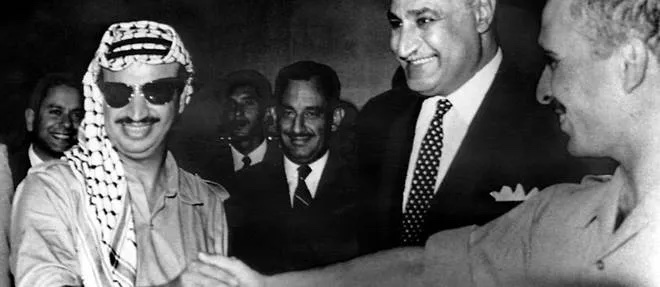 Yasser Arafat (left) and King Hussein of Jordan (right) shake hands as Nasser looks on, on Sept. 27, 1970 in Cairo, after signing a ceasefire during Black September. (Credit: AFP)
Yasser Arafat (left) and King Hussein of Jordan (right) shake hands as Nasser looks on, on Sept. 27, 1970 in Cairo, after signing a ceasefire during Black September. (Credit: AFP)
The Bush-Shamir tug-of-war vividly illustrated that when the US desired something, Israel would ultimately align its interests. It simply needed Washington to play its part.
However, this dynamic also assumed a reciprocal commitment from the other side of the arena, namely the Arab players and the Palestinians, having the will to do the same.
In the early 1990s, things were apparently going in that direction.
The exhaustion from three years of uprising in the Occupied Territories (the First Intifada), the aftermath of Iraq’s invasion of Kuwait, Arafat’s misstep alongside Saddam, the dissatisfaction of the Gulf oil monarchies with the PLO leader, and the diminishing influence of more radical Palestinian groups abroad — all contributed, for once, to a momentary dominance of moderate discourse over extremist rhetoric in a region accustomed to the opposite.
It has frequently been the case that the US, steadfast in its support for Israel, has navigated nuanced and occasionally intricate relations with Israel’s policies.
In the 1970s, then-Israeli Prime Minister Golda Meir expressed her dissatisfaction with then-Secretary of State Henry Kissinger, reproaching him for what she perceived as a lack of common ground between the two despite their shared Jewish heritage.
‘‘Golda, you must remember that first I am an American, second I am secretary of state and third I am a Jew,” Kissinger said. Meir responded, ‘‘Henry, you forget that in Israel we read from right to left.’’
Change of scenery
Let’s return to the luxurious hotel where the Palestinian delegation stayed in Washington.
After the preliminary discussions, Hanan Ashrawi, the “star” of the group who then served as the official spokesperson of the Palestinian delegation to the Middle East peace process, convened journalists for a debriefing — a skill she evidently mastered.
Three months earlier, at the Madrid conference that initiated the peace process, she had made her public debut, garnering an international reputation as a charismatic speaker championing a just cause.
On the conference evening, she fielded questions from the press, so numerous that the meeting had to be moved outdoors.
A correspondent from an American fundamentalist Christian publication, which advocates a biblical approach to the State of Israel, addressed her.
“You Muslims,” the journalist accused her, “you do this, you do that ... and you’re wrong.”
Ashrawi let him speak and then responded, “Sir, I’m a Christian!” The audience erupted in laughter.
A year and three months later, the federal capital emerged from winter, adorned with cherry blossoms.
Optimism grew among the peace talk delegations.
The world, however, had changed in the meantime.
Bill Clinton, who succeeded Bush in the White House, remained steadfast in his belief, much like his predecessor, in the US’ role as an “honest broker” in the Middle East.
Yitzhak Rabin, who took over from Shamir at the helm of the Israeli government, was in the process of instigating a profound transformation in his country’s approach.
For the first time, an Israeli prime minister was endorsing a policy that advocates the “physical separation” of Israelis and Palestinians. This pertains specifically to the Arabs residing in the West Bank and Gaza Strip — territories occupied by Israel but not annexed — and not to the Arabs living within Israeli borders and who hold Israeli nationality.
What was new about this approach was that it suggested the existence of a distinct Palestinian people, separate from other Arabs (Jordanians, Syrians, Egyptians, etc.) and from the other inhabitants of historic Palestine, whether Jewish or Arab.
Before this, the prevailing philosophy of Zionism rejected any uniqueness attributed to Palestinian Arabs. Ironically, this denial, whereby committed Zionists asserted they had arrived from various corners of Europe and beyond to reclaim a “land without a people,” coincided with another form of denial. Arab nationalism, in the name of which Palestine was regarded not as a homeland for Palestinians but merely as a province of the Arab nation, perpetuated this counternarrative.
Rabin’s transformation from a serviceman, previously regarded as a hawk in Israeli policy and who, as defense minister in 1987, issued threats to “break the back” of the Palestinian intifada, into an advocate for peace based on the establishment of a framework facilitating the coexistence of two separate states on Palestinian land, spoke volumes about the evolution of the Labor Party and the Israeli left as a whole.
Regrettably, just as this metamorphosis unfolded, another broader and more structural shift was starting to emerge within Israeli society.
Since the mid-1980s, the floodgates of Jewish immigration, notably from Russia, allowed the arrival into Israel of immigrants who were less educated and more fervent in their beliefs than previous generations. This had, in turn, prompted a gradual right-wing shift in the country’s political landscape.
In barely 15 years, the Left and the Labor Party had virtually vanished.
 Young Palestinians throw stones in Ramallah during the first intifada in 1989. (Credit: Éric Fefeberg/AFP)
Young Palestinians throw stones in Ramallah during the first intifada in 1989. (Credit: Éric Fefeberg/AFP)
Winds of optimism
But at that point, Rabin was taking the lead: delegates and journalists from around the world gathered every day of the week around the immense square building of the State Department, earnestly beginning to believe in the progress.
They paid little attention to the growing crowd of eccentrics nearby, waving banners with increasingly violent slogans: “Rabin the traitor,” “Death to Rabin,” “Rabin the executioner of Israel.”
Meanwhile, in the hushed salons of Washington’s luxurious hotels, the tongues of American diplomats began to loosen.
“What an excellent idea to have allowed people from civil society to represent Palestine,” remarked a young prodigy from the State Department, while in the adjacent room, a pianist with nimble fingers was playing Satie’s Gymnopédie.
The young man was so well-versed in the intricacies of the Middle East that he could recite the names of the 128 members of the Lebanese parliament with his eyes closed.
“Previously, for the entire world, the Palestinians were synonymous with terrorism, hijacked planes and the hostage-taking of athletes at the Munich Olympics,” he said.
“Now, America is encountering perfectly decent men and women who are saying, ‘We are Palestinians. Israel has deprived us. It’s time we acknowledged our right to a state,’” he added, stressing, “And this message, when voiced by them, is entirely acceptable to us Americans.”
This summed up the considerable distance covered since the initial sessions of bilateral negotiations in Washington.
However, it was true that, in the end, these negotiations served as a mere facade for the peace process, especially from the Palestinian perspective.
The “serious business” unfolded in the countryside near Oslo, where emissaries of Arafat and Rabin engaged in discreet discussions to reach an agreement.
Yet, let us attempt to envision Oslo without Washington. Diplomacy, after all, is also a matter of psychology.
It seemed implausible that Arafat could have appeared on the White House lawn in September 1993 to sign the agreement and exchange historic handshakes with Clinton, Rabin and Peres if all the groundwork had not been completed beforehand to render the PLO and its leader “acceptable” in the eyes of American and Western opinion.
Numerous commentators criticized the shortcomings of the Oslo Accords, and this criticism persists.
They are not entirely incorrect, as the text itself fails to address all aspects of the problem, but they have not put forth any conclusive alternatives.
Nevertheless, the historical significance lies in the fact that, for the first time, the agreement gave rise to the outline of a Palestinian executive known as the Palestinian Authority (PA).
Despite being discredited over the years, the PA not only endures today but also stands as a crucial component in any prospective resolution to the Palestinian issue.
Losing momentum
The most important thing to remember is that between 1993 and 1996, a genuine peace process was initiated for the first time in the Middle East. This process even extended to the banks of Syria’s Barada River, in the capital of Damascus, which had long been resistant to any notion of change under President Hafez al-Assad’s rule.
The miraculous occurred: following the counsel of Lebanon’s then-Prime Minister Rafik Hariri, with the assistance of Jacques Chirac, the newly elected French president, Assad consented to join a new geopolitical coalition entirely tied to the West, known as Euromed — a decision that was utterly inconceivable just a few months prior.
Euromed brought together all the countries of the European Union (15 at the time) and approximately 10 Mediterranean countries, including Lebanon and … Israel.
Euromed had the potential to achieve significant accomplishments if not for setbacks on two fronts.
First, at the Mediterranean level, the Israeli-Palestinian peace process was stalling. Second, on the European front, Germany shifted its focus eastward, compelling its allies, including a hesitant France, to prioritize the expansion of the EU toward Eastern Europe rather than establishing robust — and much-needed — partnerships with the south.
In November 1995, in Barcelona, the Euromed agreement was signed, marking a fateful month that witnessed the initial stages of the death of the peace process.
On Nov. 4, Rabin was assassinated in Tel Aviv by an extreme right-wing Jew, sending shockwaves around the world.
The supporters of the peace process were momentarily reassured that Peres, then serving as foreign minister, would step in and continue Rabin’s work. Peres, however, possessed less influence than Rabin. He struggled to bring the reluctant factions from the left and center of the Israeli political spectrum on board.
In the months following, between Feb. 25 and March 4, 1996, Hamas and the Palestinian Islamic Jihad carried out four violent suicide attacks in Jerusalem and Tel Aviv.
Peres faced public disapproval and was booed by the Israeli crowd when he visited the scenes of the attacks. Arafat, who had become president of the PA, condemned the attacks and expressed support for Israeli-Palestinian security cooperation. However, he found himself overshadowed by extremist rhetoric.
On May 29, 1996, Peres narrowly lost the elections to Benjamin Netanyahu, marking a shift to the right in Israel.
Netanyahu’s government spent three years undermining the peace process. In 1999, the Labor Party had a final interlude at the helm of the country with Ehud Barak.
Barak, who had once declared, “If I were a Palestinian, I would do the same thing as the stone-throwers are doing” in the West Bank, attempted, with the cooperation of Bill Clinton, to revive the faltering process.
Arafat, however, was no longer a key player at that time, despite his main lieutenant, Yasser Abed Rabbo, concurrently working with the Labor Party negotiator Yossi Beilin to formulate a peace plan more ambitious than the Oslo Accords.
Already undermined, the Palestinian president rejected the Israeli-American offer, leading to increased unrest among extremists taking to the streets.
First missed opportunities
Even in the 1930s, the majority of Zionist movements and organizations based in Palestine vehemently opposed the compromises proposed by Great Britain, the Mandatory Power, to address the Arab-Jewish problem (such as the White Paper, Peel Commission, etc.).
Adding insult to injury, these organizations often refrained from taking a stance and remained silent, fully aware that, in any case, Arab extremists, who were quick to voice their opposition, would reject these compromises.
This was the case, despite the fact that in the final years of the Mandate, before and even after WWII, London was objectively much more favorable to Arabs than Jews.
The partition plan for Palestine, adopted by the United Nations General Assembly in November 1947, faced a similar destiny.
Officially, it was accepted by Jews and rejected by Arabs. However, the reality was more nuanced: it is now known that many Jews were not in favor, primarily due to the special status reserved for the city of Jerusalem. Additionally, the territory theoretically allocated to them, which was slightly larger than that assigned to Arabs, actually consisted of almost 40 percent of the Negev desert.
However, those Jews opposed to the plan did not need to publicly express their objection. They were aware that Arabs would go to great lengths to obstruct the implementation of the UN resolution.
This expectation was not unfounded, especially considering that the Arab Higher Committee for Palestine was under the control of hardliners and chaired by an old acquaintance, Hajj Amin Husseini, a Palestinian Arab nationalist and Muslim leader in Mandatory Palestine. Husseini, who had ardently wished for Hitler’s victory in the war, was not inclined toward a cooperative stance.
In the Arab camp, there were also clandestine figures, albeit with opposing views.
King Abdullah of Transjordan (the great-grandfather and namesake of the current King of Jordan) secretly favored the partition plan. However, he had no intention of accepting an independent Palestinian state, as he considered the Arab part of Palestine to be rightfully his.
Ultimately, Abdullah partially realized this objective barely six months later, in the aftermath of the 1948 Nakba.
While Palestine was eventually partitioned, it did not unfold as envisioned in the UN plan. The Arab-Israeli war that erupted after the proclamation of the State of Israel on May 14, 1948, granted Jews a larger territory than initially outlined in the plan, including West Jerusalem.
As for the remaining Arab territories — East Jerusalem, the West Bank and the Gaza Strip — they would never achieve independent status as Palestine.
Was this because of Israel? No, at least not directly. Because of Arabs? Unfortunately, yes.
Transjordan officially became Jordan by annexing East Jerusalem and the West Bank, and Egypt took over the Gaza Strip.
Why this annexation? Because the Arab states neighboring Israel had no desire for an independent, uncontrollable piece of Palestine that would drag them into conflicts with Israel that they neither wanted nor planned.
Here, we are only in 1948, and there have already been numerous missed opportunities. Regrettably, many more will follow.
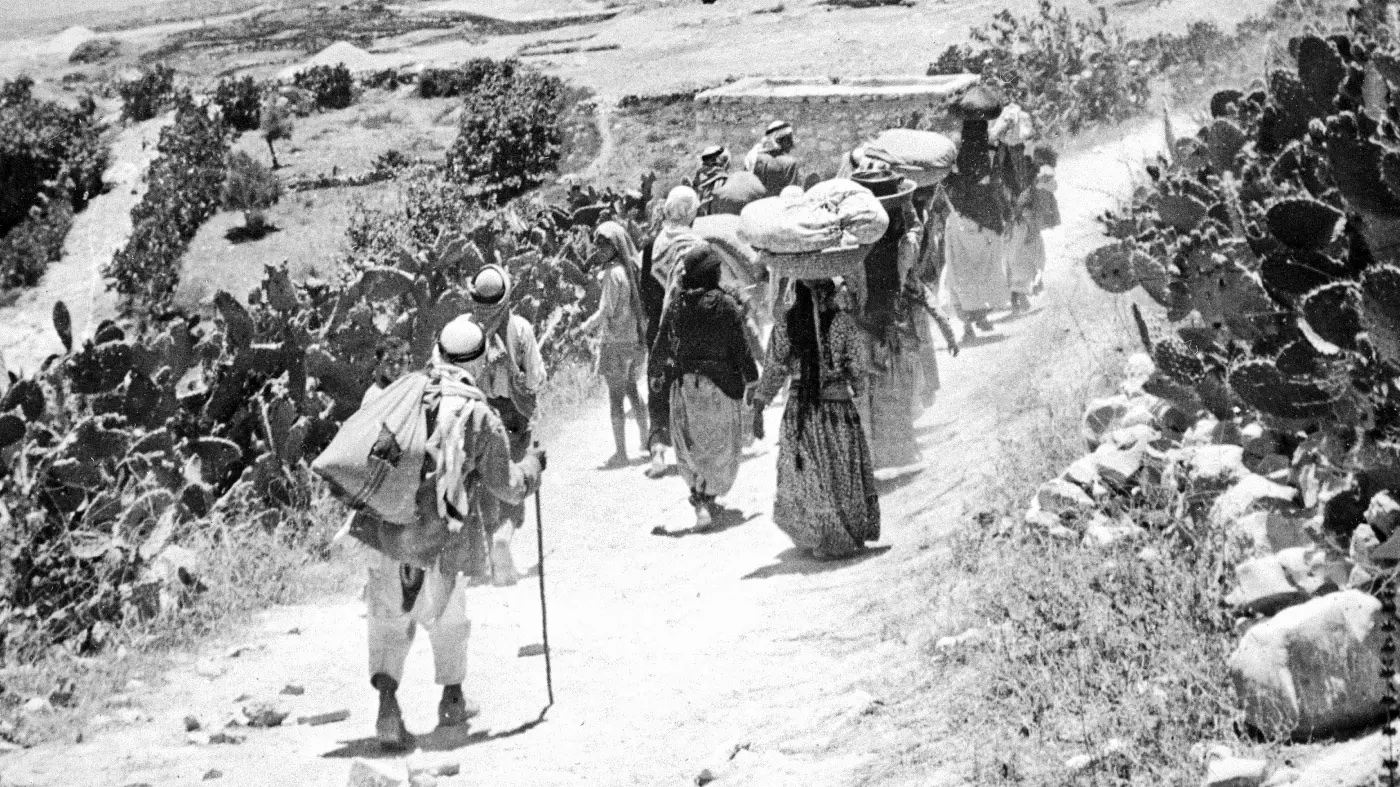 Palestinians driven from their land in 1948. (Credit: AFP)
Palestinians driven from their land in 1948. (Credit: AFP)
Nationalism and other aberrations
From that date onward, a fervent wave of Arab nationalism swept the countries of the Near and Middle East (not to mention those of the Maghreb).
This wave would encompass the Palestinian cause only to suppress it more effectively.
Everywhere, ominous militaristic and dictatorial regimes emerged, governed by the suppressive principle that “no voice should drown out the noise of battle” (La sawta yaalou fawqa sawt al-maaraka).
However, the question remained: where was this battle? The Suez campaign in 1956? This was a quintessentially post-colonial conflict in which Israel, unfortunately, aligned itself against Nasser’s Egypt but had absolutely nothing to do with the Palestinian cause.
Israel was compelled to withdraw, not due to military defeat, but in the face of the US wrath, which cared little for the claims of the French and British to preserve their colonial gains and sure did not want to see its small protégé joining the fray.
As for Gamal Abdel Nasser, his primary concern was Egypt’s hegemony over the Arab world, prioritizing this over other issues. Consequently, he sought and valued from the Palestinian cause only what served his purposes.
One of his predecessors, the renowned Egyptian patriot Saad Zaghloul, a former prime minister, founder of the Wafd party, and hero of Cairo’s liberation from London, once responded to a journalist inquiring about his thoughts on Arab unity, saying “zero + zero + zero = zero.”
If Nasser were asked the same question, he might have adjusted the formula a little: one + zero + zero + zero = one. He punished any Arab country he failed to subdue. This was evident with Syria, which, after initially being a compliant pupil between 1958 and 1961, eventually revolted against Cairo’s grip and withdrew from the “United Arab Republic.”
With the complicity of the Lebanese “second bureau,” that is, the intelligence services, the Egyptian embassy in Beirut engaged in various anti-Syrian activities with impunity, leaving Damascus with a lasting sense of bitterness and resentment toward Lebanon.
Once done with punishing Syria, Nasser turned his wrath to King Faisal of Saudi Arabia, who had the audacity to challenge him over his plans to gain a foothold in the Arabian Peninsula by exerting influence over Yemen. Tens of thousands of Egyptian soldiers would pay with their lives for this ambitious but ill-fated endeavor.
It was at this point, in the mid-1960s, that Palestinian organizations started gaining prominence and, more significantly, began offering their services to the highest bidding Arab powers.
Yasser Arafat, a man of great intelligence and charisma, attempted to bring order to this complex situation, hoping to centralize Palestinian decision-making, but his efforts proved futile.
He often found himself enmeshed in the trap of incessant one-upmanship, the prevailing mode of expression among these organizations.
It wasn’t until 1974 that Arab states collectively agreed to recognize the PLO as the sole representative of the Palestinian people, a staggering 26 years after the establishment of the State of Israel.
However, by then, it was too late for the “civilized” project that the head of the Palestinian leadership presented to the UN General Assembly that year: a single democratic state uniting Arabs and Jews.
The notion of a democratic state seemed idealistic and naive to many in the mid-1970s.
In the meantime, the unimaginable occurred: from June 5 to June 10, 1967, the Arab world suffered a colossal blow.
What should have long been the State of Palestine vanished within six days.
East Jerusalem, the West Bank, the Gaza Strip, and the Syrian Golan Heights were seized by Israel at the end of a swift war that defeated the armies of three Arab states: Egypt, Syria and Jordan.
How did it come to this? Nasser would point fingers at the Syrians, and incidentally, at the Egyptian Chief of Staff, Marshal Abdel Hakim Amer, who subsequently “committed suicide,” according to the state narrative. The Syrians, on the other hand, would pin it on the Palestinians.
In September 1967, an Arab summit took place in Khartoum, producing the famous “three no’s”: “No to peace with Israel”; “No to recognition of Israel”; “No to negotiations with Israel.” The question remained: and yes to what?
Forerunner
It wasn’t until Anwar Sadat that Egypt regained its composure and sought to make progress. In 1972, in a characteristic move, revealing the nature of a man not lacking in courage and audacity, Nasser’s successor abruptly made a 180-degree turn.
One morning, he ordered the expulsion of all Soviet advisers brought in by his late predecessor (who had passed away in September 1970) and turned to the Americans, recognizing that only with their assistance could he achieve his goals.
The following year, Sadat diligently but discreetly prepared for a limited conflict with Israel with the objective of initiating peace negotiations on honorable terms. For this to happen, the Egyptian army needed to accomplish something during the conflict that would sufficiently counteract the humiliation of June 1967.
This endeavor materialized as the October War, jointly launched by Sadat and Hafez al-Assad.
Sadat achieved his objective: an undeniable initial success.
The Syrian-Egyptian offensive significantly compromised the Israeli warning system. It would take Israel a few days to rectify the situation and regain control.
For Sadat, the essential achievement was clear: Cairo could now boast of having erased the shame of the 1967 war.
From this point onward, anything seemed possible, including the reopening of the Suez Canal, a trip to Jerusalem, peace negotiations and the eventual return of the occupied Sinai. All these developments unfolded between 1975 and 1979.
Meanwhile, Assad had different objectives. He was not inclined toward peace. His primary goal was to elevate his country, or rather his regime, to become a significant player in the region, as opposed to Syria being historically manipulated by external forces.
If he, too, wanted to overcome the humiliation of 1967, it was not for him to align himself with Israel or better serve the Palestinian cause, of which he had little interest.
On the contrary, his aim was to position Syria theoretically as the champion of the cause without having to bear any associated costs.
More precisely, Assad shifted these costs onto others — Lebanese, Palestinians and, when possible, Jordanians. He succeeded significantly with the first, to a lesser extent with the second and not at all with the third.
The consequence of these maneuvers was Egypt’s exclusion from the Arab League following its peace treaty with Israel. This was tantamount to say, the United States, on the proposal of the state of North Dakota, deciding on the exclusion of California or New York.
Sadat, the leader who restored pride to his country and brought a sense of dignity back to an Arab world humiliated by Israeli arrogance, was assassinated on Oct. 6, 1981, which marked the eighth anniversary of the October War. The killer was a fanatic who subscribed to the belief held by many Arabs that Sadat was a traitor.
In contrast, Nasser, who held significant responsibility for the disaster, is still revered by many as a hero.
This paradox is symptomatic of the afflictions that the Arab world grapples with.
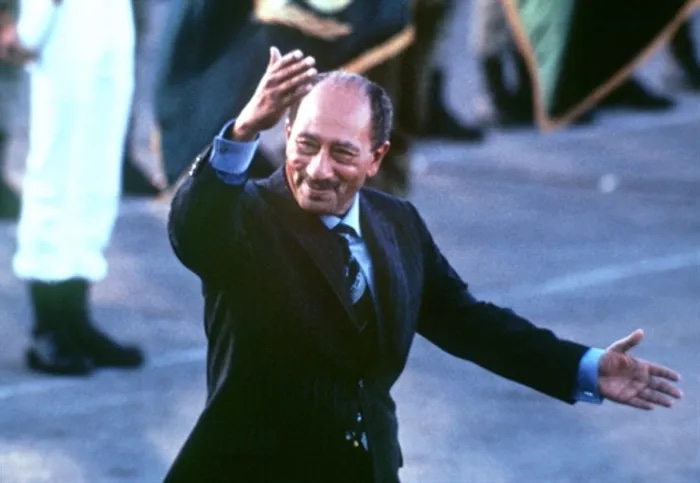 President Anwar Sadat in 1977 in Israel. (Credit: AFP)
President Anwar Sadat in 1977 in Israel. (Credit: AFP)
A solution exists
Sadat was accused of abandoning Palestine by making peace with Israel. Indeed, he did abandon it, but not more so than others.
Not more than the Palestinians, who, for the most part, also abandoned Palestine, with noteworthy exceptions such as a few civilian delegates in the 1990s in Washington, and occasionally — but only occasionally — Arafat.
Nor more than all the Arabs who have consistently abandoned Palestine, including figures like Abdullah of Transjordan, Gamal Abdel Nasser, Hafez al-Assad or Saddam Hussein.
Intellectuals of the Third Worldist Left, now known as alter-globalists, coined the concept of the centrality of the Palestinian question.
However, it has only ever been central for them and not for the Arabs, Israelis, the West or anyone else.
Nevertheless, the issue has consistently carried significant symbolic weight, as expressed by former Lebanese minister and former UN mediator in Libya, Ghassan Salameh.
This symbolic weight influences Arab and international opinions well beyond the direct protagonists of the conflict.
It can be ideological and romantic, focusing on the struggle of Arab nationalists and their Third World allies against what they perceive as the colonial legacy.
Alternatively, it can be identity-based, affecting Jews, Muslims and Christians worldwide.
However, when this symbolic weight takes effect, it distorts the real issues at stake in the Palestinian question.
Today, for example, the fervor gripping the streets of France and elsewhere has little to do with the debate on the relevance of a two-state solution in the Middle East.
Instead, it primarily reflects the growing identity-based divisions shaking society due to the challenges of integrating large sections of the immigrant population.
Consequently, it transforms into a domestic political issue, diverging significantly from the core Palestinian question.
Similarly, events unfolding today in the Middle East, and viewed through the Iranian prism today, are far from the Palestinian issue.
Tehran and its Arab proxies, with well-known agendas, take advantage of the Palestinian cause and do not serve it.
The overwhelming majority of Arabs now recognize this truth and are dismayed by it. Nevertheless, their aversion to Iranian imperialism and the Shiite revanchism manifested by Tehran’s protégés in the region does not prevent them from being captivated by the posture (or rather the imposture) of the mumanaa axis known as the “resistance,” every time the Palestine front flares up.
The reason behind this is simple: the arrogance of the Israeli right deeply offends Arab sentiment, compelling it to acquiesce to Iranian assertiveness.
Hamas cannot become the future of Palestine, just as Hezbollah cannot shape Lebanon’s destiny.
To effectively counter both factions and their Iranian sponsor, Arab leaders must dispel the conflation of moderation with acquiescence.
They must be ready to take resolute actions against the extremist Israeli government, whose greatest crime, even beyond massacring civilians in Gaza in response to the deplorable events of Oct. 7, lies in continuing to believe that this massacre can be perpetrated without a clear project or political proposal.
For the Arab leaders, including the Sissis, the Abdullah IIs, the MBSs, the MBZs, the solution exists, and it was outlined by their immediate predecessors in 2002, no less, in Beirut.
There are many people in Israel, America, Europe and around the world who support this historic compromise.
Rooted in the principle of two states and the 1967 borders, it remains the only rational resolution, aligning the nihilists on both sides and, along with them, those advocating for a more amicable normalization with Israel.
Implementing this compromise will undoubtedly demand courage and perseverance, especially in the “eviction” — to quote Ghassan Salameh once again — of most of the several hundred thousand Jewish settlers in the West Bank.
Is it a mission impossible? Not if the US throws its weight behind it. Encouraging such support, reminiscent of the days of Bush senior, will be essential.
This article was originally published in French in L'Orient-Le Jour. Translation by Sahar Ghoussoub.

